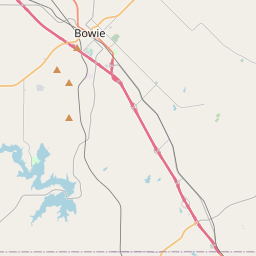Elmwood Cemetery







Early settler James W. Stallings donated the first portion of land for the establishment of a cemetery for area residents at this site in 1880. Two years later, the town of Bowie was platted near the cemetery site, along the route of the Fort Worth and Denver Railroad. The first burial at Elmwood Cemetery was that of Willie B. Nelson (d. June 10, 1880), son of Francis M. and Mary Nelson. Stallings later buried several of his own family members at the site, including his wife Sarah E. (Parker), his granddaughter and his daughter, all in 1882. In 1884, 1901 and 1905, G.W. and Emily Tinkle conveyed additional land to the cemetery, and further additions were made to the site in later years.
The Bowie Cemetery Association formed during the early years of the cemetery’s existence, although the exact date of its organization is unknown. The association handled the business of the cemetery until 1938, when the cemetery association officially deeded the burial ground to the city of Bowie. In 1981, due to the expansion of Lake Amon G. Carter, the graves located at Tarter Cemetery were relocated to Elmwood. Portions of a native stone wall that was constructed along Patterson and Nelson Streets by employees of the Civilian Conservation Corps 1935-1937 remain today.
The cemetery contains burials of veterans from the Civil War, Spanish-American War, World War I, World War II, Korea and Vietnam. Today, Elmwood Cemetery continues to serve the citizens of Bowie and the surrounding area while reminding them of the early pioneer settlers of the community
As one of the most visible programs of the Texas Historical Commission (THC), historical markers commemorate diverse topics in Texas history, including: the history and architecture of houses, commercial and public buildings, religious congregations, and military sites; events that changed the course of local and state history; and individuals who have made lasting contributions to the state, community organizations, and businesses.
In the late 19th century, Texas became known for its cattle drives, in which cowboys would move herds of cattle from Texas to railheads in Kansas and other northern states. The cattle drives were dangerous and difficult work, but they played a key role in the development of the American cattle industry.
The county's namesake, Daniel Montague, arrived in the area in 1854 and became one of the first permanent settlers. Montague County was officially established and organized in 1858, with Montague serving as its first county seat. However, due to ongoing conflicts with Native American tribes and accessibility issues, many of the early settlements faced challenges in their development.
The discovery of oil and gas reserves in Montague County in the early 1900s brought significant economic development to the region. This led to an increase in population and infrastructure, and the county experienced a boom in oil production during the mid-20th century. The county's economy diversified over time to include agriculture, manufacturing, and tourism, contributing to its growth and stability.
Today, Montague County is known for its picturesque scenery, with rolling hills, vast prairies, and scenic rivers attracting outdoor enthusiasts and nature lovers. The county also celebrates its history through its various museums, historical landmarks, and annual events, preserving the heritage and culture of the area for future generations to appreciate.
Montague County Timeline
This timeline provides a glimpse into the major events and milestones that have shaped the history of Montague County, Texas.
- 1857: Montague County is established by the Texas legislature
- 1860: The first county courthouse is built in the town of Montague
- 1861-1865: Montague County residents serve in the Confederate Army during the Civil War
- 1874: The town of Saint Jo is founded
- 1882: The Fort Worth and Denver City Railway extends into Montague County, promoting economic growth
- 1884: The town of Nocona is established
- 1900: The Montague County courthouse burns down and is subsequently rebuilt
- 1930s: The Great Depression and Dust Bowl impact the county, causing economic hardship
- 1957: The Montague County Courthouse is again destroyed by fire but is reconstructed
- 2000: The county experiences population growth and ongoing development